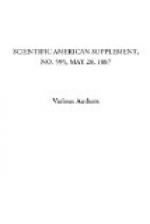This table shows conclusively that the houses nearest the hospital were in the greatest danger of small-pox. It might naturally be supposed that the excessive incidence of the disease upon the houses nearest to the hospital was due to business traffic between the hospital and the dwellers in the neighborhood, and Mr. Power admits that he started on his investigation with this belief, but with the prosecution of his work he found such a theory untenable.
ADMISSIONS OF ACUTE SMALL-POX TO FULHAM HOSPITAL, AND INCIDENCE OF SMALL-POX UPON HOUSES IN SEVERAL DIVISIONS OF THE SPECIAL AREA DURING FIVE EPIDEMIC PERIODS.
+-------+---------------------+------------------------
------------------------+ | | Incidence on every 100 houses within the | | | special area and its divisions. | Cases of|The epidemic periods +--------+---------+---------+---------+---------+ acute |since opening |On total|On small |On first |On second|On third | small- |of hospital. |special | circle, | ring, | ring, | ring, | pox. | | area. |0-1/4 mile.|1/4-1/2 mile.|1/2-3/4 mile.|3/4-1 mile.| --------+---------------------+--------+---------+---------+
---------+---------+ 327 |March-December 1877 | 1.10 | 3.47 | 1.37 | 1.27 | 0.36 | 714 |January- | | | | | | | September, 1878 | 1.80 | 4.62 | 2.55 | 1.84 | 0.67 | 679 |September 1878- | | | | | | | October 1879 | 1.68 | 4.40 | 2.63 | 1.49 | 0.64 | 292 |October, 1879- | | | | | | | December, 1880 | 0.58 | 1.85 | 1.06 | 0.30 | 0.28 | 515 |December 1880- | | | | | | | April 1881 | 1.21 | 2.00 | 1.54 | 1.25 | 0.61 | --------+---------------------+--------+---------+---------+
---------+---------+ 2,527 |Five periods | 6.37 | 16.34 | 9.15 | 6.15 | 2.56 | --------+---------------------+--------+---------+---------+
---------+---------+
Now, the source of infection in cases of small-pox is often more easy to find than in cases of some other forms of infectious disease, and mainly for two reasons:
1. That the onset of small-pox is usually sudden and striking, such as is not likely to escape observation.




